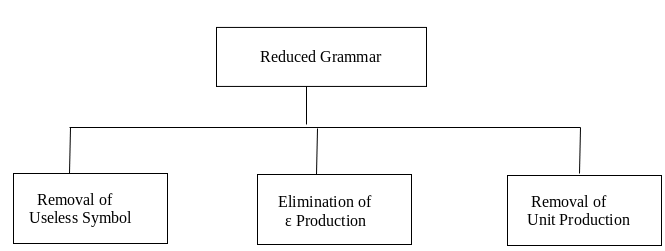Simplification of CFG
As we have seen, various languages can efficiently be represented by a context-free grammar. All the grammar are not always optimized that means the grammar may consist of some extra symbols(non-terminal). Having extra symbols, unnecessary increase the length of grammar. Simplification of grammar means reduction of grammar by removing useless symbols. The properties of reduced grammar are given below:
- Each variable (i.e. non-terminal) and each terminal of G appears in the derivation of some word in L.
- There should not be any production as X → Y where X and Y are non-terminal.
- If ε is not in the language L then there need not to be the production X → ε.

Removal of Useless Symbols
A symbol can be useless if it does not appear on the right-hand side of the production rule and does not take part in the derivation of any string. That symbol is known as a useless symbol. Similarly, a variable can be useless if it does not take part in the derivation of any string. That variable is known as a useless variable.
For Example:
T → aaB | abA | aaT
A → aA
B → ab | b
C → ad
In the above example, the variable 'C' will never occur in the derivation of any string, so the production C → ad is useless. So we will eliminate it, and the other productions are written in such a way that variable C can never reach from the starting variable 'T'.
Production A → aA is also useless because there is no way to terminate it. If it never terminates, then it can never produce a string. Hence this production can never take part in any derivation.
To remove this useless production A → aA, we will first find all the variables which will never lead to a terminal string such as variable 'A'. Then we will remove all the productions in which the variable 'B' occurs.
Elimination of ε Production
The productions of type S → ε are called ε productions. These type of productions can only be removed from those grammars that do not generate ε.
Step 1: First find out all nullable non-terminal variable which derives ε.
Step 2: For each production A → a, construct all production A → x, where x is obtained from a by removing one or more non-terminal from step 1.
Step 3: Now combine the result of step 2 with the original production and remove ε productions.
Example:
Remove the production from the following CFG by preserving the meaning of it.
S → XYX
X → 0X | ε
Y → 1Y | ε
Solution:
Now, while removing ε production, we are deleting the rule X → ε and Y → ε. To preserve the meaning of CFG we are actually placing ε at the right-hand side whenever X and Y have appeared.
Let us take
S → XYX
If the first X at right-hand side is ε. Then
S → YX
Similarly if the last X in R.H.S. = ε. Then
S → XY
If Y = ε then
S → XX
If Y and X are ε then,
S → X
If both X are replaced by ε
S → Y
Now,
S → XY | YX | XX | X | Y
Now let us consider
X → 0X
If we place ε at right-hand side for X then,
X → 0
X → 0X | 0
Similarly Y → 1Y | 1
Collectively we can rewrite the CFG with removed ε production as
S → XY | YX | XX | X | Y
X → 0X | 0
Y → 1Y | 1
Removing Unit Productions
The unit productions are the productions in which one non-terminal gives another non-terminal. Use the following steps to remove unit production:
Step 1: To remove X → Y, add production X → a to the grammar rule whenever Y → a occurs in the grammar.
Step 2: Now delete X → Y from the grammar.
Step 3: Repeat step 1 and step 2 until all unit productions are removed.
For example:
S → 0A | 1B | C
A → 0S | 00
B → 1 | A
C → 01
Solution:
S → C is a unit production. But while removing S → C we have to consider what C gives. So, we can add a rule to S.
S → 0A | 1B | 01
Similarly, B → A is also a unit production so we can modify it as
B → 1 | 0S | 00
Thus finally we can write CFG without unit production as
S → 0A | 1B | 01
A → 0S | 00
B → 1 | 0S | 00
C → 01




No comments:
Post a Comment